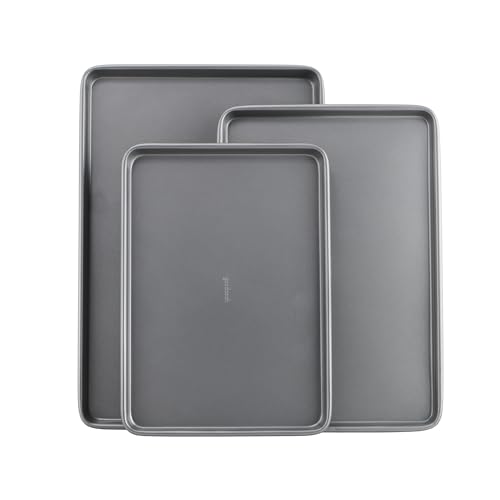
Wilton Cookie Sheet
| Pros | Cons |
|---|---|
|
|
Our content is meticulously curated through independent research, testing, reviews, and AI-driven recommendations, all designed to present you with the finest product choices. When you make a purchase through our links, it could result in us earning a commission.

Ever tried to make cookies but ended up with a catastrophe? It might not be your skills that failed you but your bakeware! Without high-quality cookie sheets, you’ll struggle with issues like poor heat conduction and discolored foods. Luckily, buying new cookie sheets isn't so hard when we've already done all the hard work for you! We've tested the best cookie sheets of 2024 to bring you our handpicked list of premier cookie sheets available online. The Wilton Cookie Sheet takes the cake as our favorite item on this list, but if you want more options, read on to learn more!
Now that you have an idea of all the great cookie sheets out there, you are probably excited to purchase one. But, before you do that you need to consider what features will work best for you. How much cookie mix do you plan to make and do you need a large sheet for making big batches? Or, perhaps you want a colorful cookie sheet that will match your kitchen’s overall vibe. This can be a lot to consider, so we went ahead and did the research for you. Here’s a look at all the small details you should consider when purchasing your cookie sheets.
Cookie sheets are susceptible to all sorts of damage over long-term use. They can either start flaking off their non-stick layer after some rough cycles of baking and cleaning or simply warp and deform under extremely high temperatures. They can even get rusty over time if you wash them enough times, especially if they don’t have enough rust resistance. Your best bet against most of these durability issues is a high-strength steel construction, especially heavy-gauge steel.
The right choice of cookie sheets for your cooking (and eating) preferences also depends on the shade of color you like on your cookies. If you’re a fan of those lightly tanned or golden cookies, your best bet is to get one of those shiny shortbread sheets that aren’t supposed to brown the cookies at the bottom. For golden brown cookies, go for lighter-colored metals. Similarly, dark-colored cookie sheets (either due to high usage or by design) will give you the best results if you’re after those overly browned cookie batches.
A cookie tray's nonstick coating can make or break your entire baking experience with it. High-quality ones allow you to skip greasing the sheet altogether, and the baked batch still comes off like melted butter! You don’t even have to use any parchments or oil spray to lubricate the surface beforehand. But unfortunately, very few sheets offer that level of sustained non-stick performance. You should religiously look for this feature if you plan on making those smooth-bottom thick cookies, as they’re pretty impossible to bake without an effective nonstick coating. Be sure to carefully read each sheet’s customer reviews to not only see how great its baking release is but also how it holds up after a few uses.
Lastly, the size of your cookie sheet is also a key consideration. The bigger it is, the more cookies you can fit per batch! But try not to go overboard and make sure your baking tray matches the size of your oven. As a general rule of thumb, ensure that there are at least two inches of leeway between the tray and the oven walls on each side to allow sufficient room for air circulation and even baking.
Here’s another key question to ask yourself before starting to navigate the cookie sheet market. Do you need sides or not? It’s one of the trendiest questions on popular baking forums, and professionals on both sides of the spectrum have very strong opinions about it. The no-side wing strongly believes that having sides on your cookie sheets will restrict air flow, leading to unevenness in the batch in terms of color, cooking, and consistency. They also point out that having no sides on the tray makes it easier to slide baked cookies off, as well as having a larger surface area to work with. Proponents of the sided pan, however, insist that having sides on a baking tray has no noticeable impact on the success of your baking, and you get lots of versatility out of your cookie sheet without sacrificing any baking effectiveness. At the end of the day, it’s your own decision to pick one of the two sides as long as you keep both of these arguments in view.

| Pros | Cons |
|---|---|
|
|

| Pros | Cons |
|---|---|
|
|

| Pros | Cons |
|---|---|
|
|

| Pros | Cons |
|---|---|
|
|

| Pros | Cons |
|---|---|
|
|